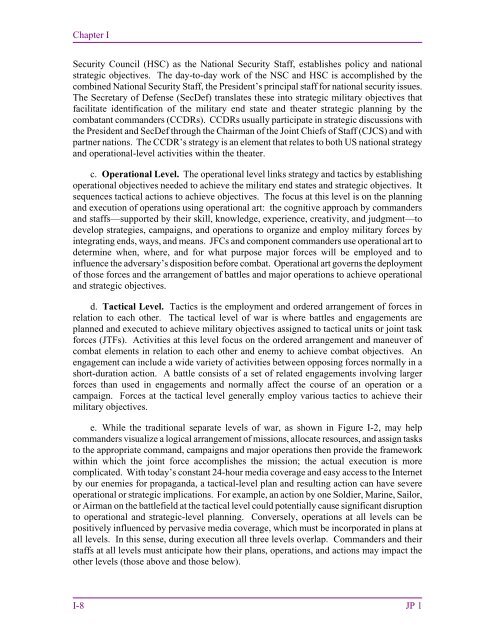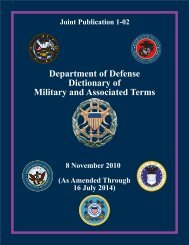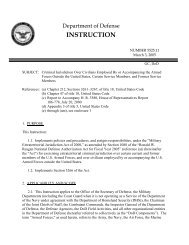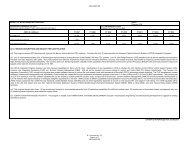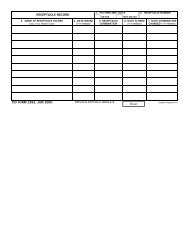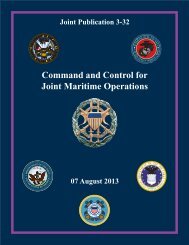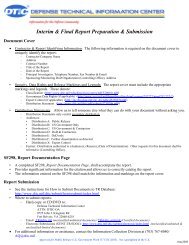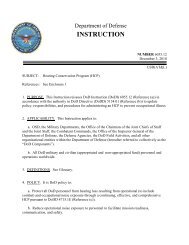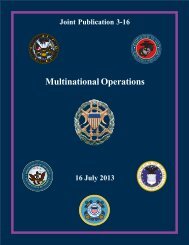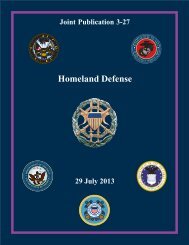JP 1, Doctrine for the Armed Forces of the United States - Defense ...
JP 1, Doctrine for the Armed Forces of the United States - Defense ...
JP 1, Doctrine for the Armed Forces of the United States - Defense ...
Create successful ePaper yourself
Turn your PDF publications into a flip-book with our unique Google optimized e-Paper software.
Chapter I<br />
Security Council (HSC) as <strong>the</strong> National Security Staff, establishes policy and national<br />
strategic objectives. The day-to-day work <strong>of</strong> <strong>the</strong> NSC and HSC is accomplished by <strong>the</strong><br />
combined National Security Staff, <strong>the</strong> President’s principal staff <strong>for</strong> national security issues.<br />
The Secretary <strong>of</strong> <strong>Defense</strong> (SecDef) translates <strong>the</strong>se into strategic military objectives that<br />
facilitate identification <strong>of</strong> <strong>the</strong> military end state and <strong>the</strong>ater strategic planning by <strong>the</strong><br />
combatant commanders (CCDRs). CCDRs usually participate in strategic discussions with<br />
<strong>the</strong> President and SecDef through <strong>the</strong> Chairman <strong>of</strong> <strong>the</strong> Joint Chiefs <strong>of</strong> Staff (CJCS) and with<br />
partner nations. The CCDR’s strategy is an element that relates to both US national strategy<br />
and operational-level activities within <strong>the</strong> <strong>the</strong>ater.<br />
c. Operational Level. The operational level links strategy and tactics by establishing<br />
operational objectives needed to achieve <strong>the</strong> military end states and strategic objectives. It<br />
sequences tactical actions to achieve objectives. The focus at this level is on <strong>the</strong> planning<br />
and execution <strong>of</strong> operations using operational art: <strong>the</strong> cognitive approach by commanders<br />
and staffs—supported by <strong>the</strong>ir skill, knowledge, experience, creativity, and judgment—to<br />
develop strategies, campaigns, and operations to organize and employ military <strong>for</strong>ces by<br />
integrating ends, ways, and means. JFCs and component commanders use operational art to<br />
determine when, where, and <strong>for</strong> what purpose major <strong>for</strong>ces will be employed and to<br />
influence <strong>the</strong> adversary’s disposition be<strong>for</strong>e combat. Operational art governs <strong>the</strong> deployment<br />
<strong>of</strong> those <strong>for</strong>ces and <strong>the</strong> arrangement <strong>of</strong> battles and major operations to achieve operational<br />
and strategic objectives.<br />
d. Tactical Level. Tactics is <strong>the</strong> employment and ordered arrangement <strong>of</strong> <strong>for</strong>ces in<br />
relation to each o<strong>the</strong>r. The tactical level <strong>of</strong> war is where battles and engagements are<br />
planned and executed to achieve military objectives assigned to tactical units or joint task<br />
<strong>for</strong>ces (JTFs). Activities at this level focus on <strong>the</strong> ordered arrangement and maneuver <strong>of</strong><br />
combat elements in relation to each o<strong>the</strong>r and enemy to achieve combat objectives. An<br />
engagement can include a wide variety <strong>of</strong> activities between opposing <strong>for</strong>ces normally in a<br />
short-duration action. A battle consists <strong>of</strong> a set <strong>of</strong> related engagements involving larger<br />
<strong>for</strong>ces than used in engagements and normally affect <strong>the</strong> course <strong>of</strong> an operation or a<br />
campaign. <strong>Forces</strong> at <strong>the</strong> tactical level generally employ various tactics to achieve <strong>the</strong>ir<br />
military objectives.<br />
e. While <strong>the</strong> traditional separate levels <strong>of</strong> war, as shown in Figure I-2, may help<br />
commanders visualize a logical arrangement <strong>of</strong> missions, allocate resources, and assign tasks<br />
to <strong>the</strong> appropriate command, campaigns and major operations <strong>the</strong>n provide <strong>the</strong> framework<br />
within which <strong>the</strong> joint <strong>for</strong>ce accomplishes <strong>the</strong> mission; <strong>the</strong> actual execution is more<br />
complicated. With today’s constant 24-hour media coverage and easy access to <strong>the</strong> Internet<br />
by our enemies <strong>for</strong> propaganda, a tactical-level plan and resulting action can have severe<br />
operational or strategic implications. For example, an action by one Soldier, Marine, Sailor,<br />
or Airman on <strong>the</strong> battlefield at <strong>the</strong> tactical level could potentially cause significant disruption<br />
to operational and strategic-level planning. Conversely, operations at all levels can be<br />
positively influenced by pervasive media coverage, which must be incorporated in plans at<br />
all levels. In this sense, during execution all three levels overlap. Commanders and <strong>the</strong>ir<br />
staffs at all levels must anticipate how <strong>the</strong>ir plans, operations, and actions may impact <strong>the</strong><br />
o<strong>the</strong>r levels (those above and those below).<br />
I-8 <strong>JP</strong> 1


